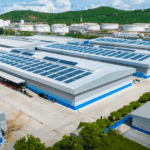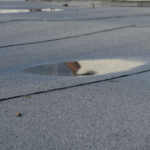
Today, sustainability isn’t just a buzzword in construction and building management, it’s a necessity. Building owners, architects, and developers are increasingly seeking eco-friendly solutions that not only cut operational costs but also meet green building standards. One solution that has been gaining attention is reflective roofing systems, which help improve energy efficiency, extend the life of roofs, and qualify for a variety of green building incentives.
Silicoat Roofing has emerged as a leader in this space with its advanced reflective silicone coatings. Designed to protect roofs while boosting energy savings, these coatings offer both performance and sustainability. In this article, we’ll take a closer look at how Silicoat’s reflective coatings qualify for green building incentives, their environmental benefits, and how they can help property owners save money over the long term.
Understanding Reflective Coatings and Their Benefits
Reflective coatings, often referred to as “cool roofs,” are specially formulated materials applied to roofing surfaces to reflect sunlight and reduce heat absorption. Traditional roofing materials such as asphalt and dark-colored shingles absorb significant amounts of solar energy, leading to higher surface temperatures, increased cooling loads, and faster roof deterioration. Silicoat’s reflective coatings, however, are designed with high solar reflectance and thermal emittance, providing a multi-layered approach to roof protection and energy efficiency.
Key Benefits of Silicoat’s Reflective Coatings
1. Significant Energy Savings
The primary advantage of reflective coatings is their ability to reduce the heat transferred into a building. By reflecting a larger portion of sunlight, Silicoat’s coatings reduce indoor temperatures, particularly in commercial and industrial buildings with large roof surfaces. This translates into lower energy consumption for air conditioning systems, which can significantly reduce utility bills over the long term. In hot climates, the energy savings can be substantial, making these coatings a financially sound investment.
2. Extended Roof Life
Roofing systems are subjected to constant exposure from the elements, including ultraviolet (UV) rays, rain, and extreme temperatures. Silicoat’s silicone-based reflective coatings provide a protective barrier that prevents UV degradation, thermal cracking, and ponding water damage. By minimizing wear and tear, these coatings extend the life of the roof membrane, reduce maintenance costs, and delay the need for full roof replacement, offering both economic and environmental benefits.

3. Reduced Carbon Footprint
Energy-efficient buildings contribute directly to lowering greenhouse gas emissions. By decreasing the energy demand for cooling, reflective coatings reduce reliance on electricity generated from fossil fuels. The result is a smaller carbon footprint for the building, aligning with corporate sustainability goals and regulatory requirements. Buildings that adopt reflective coatings are not only saving money but also actively participating in environmental stewardship.
4. Enhanced Indoor Comfort
Silicoat’s coatings not only reduce energy consumption but also improve thermal comfort inside the building. By maintaining more stable indoor temperatures, employees, tenants, or residents experience a more comfortable environment, reducing complaints related to heat and increasing overall productivity in commercial settings.
Reflective Coatings and Green Building Incentives
Sustainability initiatives and green building certifications have become key drivers in the adoption of energy-efficient building materials. Silicoat’s reflective coatings are designed to meet these standards and qualify for multiple green building incentives.
LEED Certification
The Leadership in Energy and Environmental Design (LEED) certification is one of the most widely recognized green building programs worldwide. Managed by the U.S. Green Building Council (USGBC), LEED evaluates buildings on a range of sustainability criteria, including energy efficiency, materials selection, water conservation, and indoor environmental quality.
Silicoat’s reflective coatings can contribute to earning LEED credits in several ways:
- Heat Island Reduction: By reflecting sunlight and reducing roof surface temperatures, reflective coatings mitigate the urban heat island effect. Buildings that adopt reflective coatings can earn points under the Sustainable Sites category, which emphasizes reducing heat absorption in urban areas.
- Optimize Energy Performance: The energy savings generated by reflective coatings directly support credits under the Energy and Atmosphere category. Buildings that reduce their energy use compared to baseline models can earn substantial points toward LEED certification.
- Durable Materials and Reduced Maintenance: Long-lasting, high-performance roofing materials such as silicone coatings contribute to LEED credits under the Materials and Resources category. Fewer replacements over time reduce material consumption, further enhancing sustainability.

Energy Efficiency Incentives
Beyond LEED, numerous federal, state, and local programs reward property owners for implementing energy-saving technologies. Silicoat’s reflective coatings are eligible for a variety of financial incentives:
- Tax Credits for Energy-Efficient Installations: Many regions offer tax deductions or credits for energy-efficient building components, including cool roofing systems. By applying Silicoat’s reflective coatings, property owners may qualify for these incentives, effectively offsetting part of the installation cost.
- Utility Rebates: Several energy providers have programs that reward businesses for reducing electricity consumption. Reflective roof coatings lower cooling demands, often qualifying buildings for rebates or direct financial incentives from utilities.
- Municipal Programs: Some cities actively promote reflective roofing to combat local heat island effects. Incentive programs may include grant funding, reduced permit fees, or recognition programs that highlight eco-friendly building initiatives.
By qualifying for these incentives, Silicoat’s coatings provide an attractive financial proposition in addition to their environmental benefits.
Mitigating the Urban Heat Island Effect
The urban heat island (UHI) effect occurs when cities experience higher temperatures than surrounding rural areas due to human activities and heat-absorbing surfaces like asphalt, concrete, and dark roofs. Elevated urban temperatures increase energy demand, exacerbate air pollution, and negatively impact public health. Silicoat’s reflective coatings play a critical role in mitigating this effect.
How Silicoat Contributes to UHI Mitigation:
- Lower Roof Temperatures: Reflective coatings can reduce roof surface temperatures by as much as 50°F compared to conventional dark roofs. This cooling effect extends beyond the building itself, helping lower ambient temperatures in the surrounding area.
- Improved Air Quality: Reduced reliance on air conditioning means less electricity generation from fossil fuels, which reduces emissions of pollutants such as nitrogen oxides and particulate matter.
- Energy Conservation Across Urban Areas: When multiple buildings in a city adopt reflective coatings, the collective reduction in energy consumption helps ease the demand on local power grids during peak usage periods.
By addressing the urban heat island effect, Silicoat’s coatings contribute to healthier, more sustainable cities while supporting broader environmental initiatives.
Additional Environmental Advantages
Silicoat’s reflective coatings also offer a range of additional environmental benefits that further enhance their eligibility for green building incentives:
1. Water Runoff Management
While reflective coatings are primarily designed for energy efficiency, they also play a role in managing rainwater. By maintaining roof integrity and preventing surface degradation, these coatings reduce the likelihood of leaks and promote efficient water runoff management. This can indirectly support green building credits related to stormwater management and site sustainability.
2. Contribution to Sustainable Construction Practices
Silicone coatings are applied directly over existing roofs, reducing the need for full roof replacements and the associated material waste. This practice aligns with sustainable construction principles by minimizing landfill contributions and conserving raw materials.
3. Support for Renewable Energy Integration
Buildings with reflective coatings maintain lower roof temperatures, which can improve the efficiency of rooftop solar panels. Cooler surfaces enhance photovoltaic performance, indirectly supporting renewable energy adoption and further enhancing energy savings.
Economic and Long-Term Benefits for Property Owners
While the environmental advantages of reflective coatings are significant, the financial implications are equally compelling. Silicoat’s coatings represent a strategic investment for building owners and developers:
- Reduced Energy Bills: Lower cooling loads directly translate into cost savings, which can be substantial over the lifespan of the coating.
- Minimized Maintenance Costs: Enhanced roof durability and resistance to weathering reduce maintenance expenses, repair frequency, and associated labor costs.
- Property Value Enhancement: Green-certified buildings often command higher market values and rental rates, attracting environmentally conscious tenants and investors.
- Incentive Utilization: Accessing tax credits, utility rebates, and municipal incentives can significantly offset installation costs, providing immediate financial benefits alongside long-term savings.
By combining energy efficiency, durability, and eligibility for green incentives, Silicoat’s reflective coatings offer both environmental responsibility and sound financial returns.

Why Silicoat Stands Out
Not all reflective coatings are created equal. Silicoat Roofing has developed formulations that offer superior performance compared to standard reflective products:
- High Solar Reflectance: Silicoat coatings reflect a higher percentage of sunlight, providing more effective heat reduction.
- Long-Term Durability: The silicone-based formulation resists cracking, peeling, and UV degradation, ensuring lasting performance.
- Ease of Application: Silicoat coatings can be applied to a variety of roof surfaces, reducing installation complexity and costs.
- Sustainability Commitment: Silicoat Roofing prioritizes eco-friendly solutions, ensuring that their products align with modern green building expectations.
These differentiators make Silicoat’s reflective coatings a preferred choice for building owners seeking to maximize energy savings, qualify for incentives, and demonstrate environmental responsibility.
Why Silicoat’s Reflective Coatings Are the Smart Choice for Sustainable Buildings
Silicoat’s reflective silicone coatings represent a compelling solution for building owners, architects, and developers seeking to enhance sustainability, reduce operational costs, and qualify for green building incentives. By improving energy efficiency, extending roof lifespan, mitigating the urban heat island effect, and supporting LEED and other green certification programs, these coatings offer a multifaceted approach to sustainable building practices.
As the focus on environmentally responsible construction intensifies, Silicoat Roofing stands out as an industry leader, delivering advanced solutions that meet the highest standards of performance and sustainability. Investing in reflective coatings is not just an environmentally conscious decision, it is a financially sound strategy that provides long-term value, energy savings, and enhanced building performance.
For commercial or industrial buildings looking to reduce energy consumption, extend roof life, and qualify for green incentives, Silicoat’s reflective coatings provide a trusted, high-performance solution that benefits both the environment and the bottom line.


 Previous Post
Previous Post Next Post
Next Post